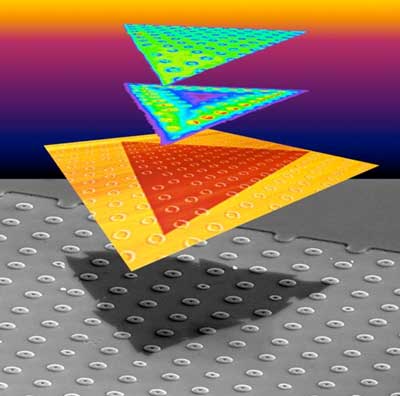
Two-dimensional (2D) materials could offer new building blocks for future technologies — but only if scientists can control growth and properties. Strain, caused by “stretching” or “bunching” the atomic structure as a crystal grows, is one way to control these properties.
Scientists grew tungsten disulfide 2D crystals over donut shapes. With this approach, they created strain that changed the materials’ growth dynamics and light emission properties (Science Advances, “Strain tolerance of two-dimensional crystal growth on curved surfaces”).
When scientists stretch 2D crystal films, they change these materials’ properties. Engineered strain can provide a new way for scientists to tailor how they make and determine the properties of 2D crystal films. This is especially important for applications that require control of the differences in energy between electrons tied to an atom’s nucleus and electrons that can move freely through a solid. (For example, the electrons that can move freely often conduct electricity.) Controlling these band gaps is critical for collecting energy and creating transformations between phases in quantum information science.
A novel method to control the properties of single layers of tungsten disulfide (WS2) crystals that enables conversion of electrical energy into light (optoelectronics) has been demonstrated by introducing precisely controlled localized strain. The properties are of interest for future technologies, including energy harvesting and quantum information sciences.
Scientists developed a method to introduce strain as they synthesize the layers. Scientists use chemical vapor deposition to deposit the films on substrates that have first been lithographically patterned with three-dimensional features such as trenches and tori (donut shapes). WS2 films that are only one atomic layer thick (or two-dimensional) are flexible, so they are able to grow over certain shapes conformally, like paint covering a rough wall.
The films grow over the sharp, linear steps of trenches as deep as 180 nanometers (nm) without the need to stretch. For reference, a sheet of paper is about 100,000 nm thick. However, in the case of shapes with both positive and negative curvature (such as a donut shape), the films stretch and bunch to cover the shape. Over donut shapes 20 nm and 40 nm tall, this stretching induces strain that accelerates the growth rate and changes the optoelectronic properties of the WS2 films.
The team has developed a model that explains that the accelerated crystal growth caused by the strain is because of an increase in the number of sites at which new particles are deposited during film growth (nucleation). When the height of the donut or trench is too high (above 40 nm), the strain becomes too high, and the films crack to release the strain. New crystals nucleate at these cracks and grow in each new direction.
Scientists studied the optoelectronic properties of the strained, uncracked WS2 films by probing how the intensity of the emitted light varied as the intensity of the energy used to initiate the emission was altered. The wavelength of the emitted light increased in the strained regions compared to the unstrained areas, indicating that the electronic band gap of the crystal has decreased locally in the strained regions.
Remarkably, this change in optoelectronic properties persisted even after the WS2 films were removed from the patterned substrates and placed on a flat surface. These results provide a synthetic strategy to engineer the strain of 2D materials in three dimensions to achieve predetermined optoelectronic properties, phase transformations, and other effects important for quantum information science and other emergent applications.
Source: Oak Ridge National Laboratory
To perform a risk assessment of nanomaterials in the environment, information on the exposure, i.e. the amounts that are present in the environment, is essential. In contrast to many other known pollutants, the concentrations of nanomaterials in environmental systems cannot be measured directly. In this situation, exposure modelling is a solution to estimate the environmental exposure with synthetic nanomaterials.
Read moreVirtual reality (VR) and augmented reality (AR) are some of the hottest multidisciplinary technology trends right now, integrating computer, various sensor, graphic image, communication, measurement and control multimedia, artificial intelligence, and other technologies.
Read more
